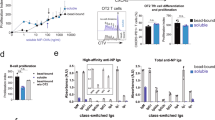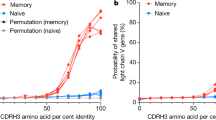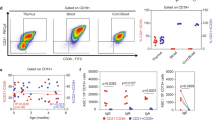Abstract
THE humoral immune response to most antigenic determinants is characterised by a highly heterogeneous population of antibody molecules derived from a large array of precursor cell clonotypes1–3. The response to certain antigenic determinants, however, is relatively restricted and may be dominated by a single homogeneous antibody species. In inbred strains of mice, such dominant antibody specificities are present in all individuals of a strain4–9, are characterised by identical idiotypic determinants4–8, and are linked to heavy chain allotype markers7–10. Thus, these clonotypes are presumed to be a direct reflection of genetic information present in the germ line. A good example of an antibody specificity considered to be ‘germ line’ is the major clonotype responsive to phosphorylcholine in BALB/c mice, which is identical in its combining region to the TEPC 15 and SI07 plasmacytoma proteins4–5. Representatives of the cell clone producing this phosphoryilcholme-specific antibody have been found in high frequency (19±6 per 106 bone marrow-derived antibody-forming cell precursors (B cells)) in both conventionally reared and germ-free BALB/c mice11.
This is a preview of subscription content, access via your institution
Access options
Subscribe to this journal
Receive 51 print issues and online access
$199.00 per year
only $3.90 per issue
Buy this article
- Purchase on Springer Link
- Instant access to full article PDF
Prices may be subject to local taxes which are calculated during checkout
Similar content being viewed by others
References
Kreth, H. W., and Williamson, A. R., Eur. J. Immun., 3, 141–146 (1973).
Klinman, N. R., J. exp. Med., 136, 241–260 (1972).
Press, J. L., and Klinman, N. R., Eur. J. Immun., 4, 155–159 (1974).
Claflin, J., Lieberman, R., and Davie, J., J. Immun., 112, 1747–1756 (1974).
Cosenza, H., and Kohler, H., Science, 176, 1027–1029 (1972).
Gearhart, P. J., Sigal, N. H., and Klinman, N. R., J. exp. Med., 141, 56–71 (1975).
Eichmann, K., J. exp. Med., 137, 603–621 (1973).
Pawlak, L. L., and Nisonoff, A., J. exp. Med., 137, 855–869 (1972).
Imanishi, T., and Mäkelä, O., J. exp. Med., 140, 1498–1510 (1974).
Lieberman, R., Potter, M., Mushinski, E., Humphery, W., and Rudikoff, S., J. exp. Med., 139, 983–1001 (1974).
Sigal, N. H., Gearhart, P. J., and Klinman, N. R., J. Immun., 114, 1354–1358 (1975).
Press, J. L., and Klinman, N. R., J. Immun., 111, 829–835 (1973).
Klinman, N. R., and Press, J. L., J. exp. Med., 141, 1133–1146 (1975).
Sherwin, W., and Rowlands, D. T., Jr, J. Immun., 113, 1353–1360 (1974).
Silverstein, A. M., Uhr, J. W., Kraner, K. L., and Lukes, R. I., J. exp. Med., 117, 799–812 (1963).
Klinman, N. R., and Press, J. L., Transplant. Rev., 24, 41–83 (1975).
Author information
Authors and Affiliations
Rights and permissions
About this article
Cite this article
SIGAL, N., GEARHART, P., PRESS, J. et al. Late acquisition of a germ line antibody specificity. Nature 259, 51–52 (1976). https://doi.org/10.1038/259051a0
Received:
Accepted:
Issue Date:
DOI: https://doi.org/10.1038/259051a0
This article is cited by
-
Innate-like B cells
Springer Seminars in Immunopathology (2005)
-
Developmental aspects of B-cell repertoire phenotype
Survey of Immunologic Research (1983)
-
IgG antibodies to phosphorylcholine exhibit more diversity than their IgM counterparts
Nature (1981)
-
Defining the immune mechanism with monoclonal antibodies
In Vitro (1981)
Comments
By submitting a comment you agree to abide by our Terms and Community Guidelines. If you find something abusive or that does not comply with our terms or guidelines please flag it as inappropriate.



